Afghanistan
 From Rationalwiki
From Rationalwiki _-_AFG_-_UNOCHA.svg.png)
“”
When you're wounded and left on Afghanistan's plains, |
| —Rudyard Kipling |
Afghanistan (Pashto: افغانستان Afġānistān; Dari: افغانستان Afġānestān), officially the Islamic Emirate of Afghanistan (Pashto: د افغانستان اسلامي امارت Da Afġānistān Islāmī Amārāt), is a large battlefield and failed state located in Central Asia. The country and region have several claims to fame. The first comes from the fact that multiple powerful historical empires met with failure when attempting to occupy the region, most notably the various post-Muhammad caliphates, the Safavids, the British Empire, the Soviet Union, and the United States. For this reason, Afghanistan is sometimes called the "Graveyard of Empires."[2] Secondly, Afghanistan was home to the United States' military operation against the Taliban, which started in 2001 and ended in 2021.[3]
Much of Afghanistan's resilience can be attributed to its geography, as it is dominated by some of the highest and most jagged mountains in the world, including the Hindu Kush and the so-called "Pamir Knot", where the Hindu Kush, Pamir, Tian Shan, Kunlun, and the Himalayas all meet.[2] Afghanistan is also populated mainly by the Pashtun ethnic group, a tribal and fiercely individualistic people who distrust outsiders and don't like being told what to do. The unwritten Pashtun code of living is called "Pashtunwali", and it values undying loyalty and vicious blood feuds in roughly equal amounts.[4]
Afghanistan's history goes back a long way, and it has almost always been an important region due to its position on the Silk Road trade route between Imperial China and the rest of the world. Thus, Afghanistan has had to tell multiple groups of people to fuck off, including Alexander the Great and the Mauryan Empire. During the rapid conquest by Arab Muslims, Afghanistan remained a tough nut to crack, and Islam didn't penetrate the mountains until many centuries later. As a newly-Islamic region, Afghanistan became an autonomous province of the Mughal Empire before creating its own state under the Durrani dynasty in the 18th century. Around this time, the British rolled in while conquering India, and Afghanistan suffered multiple attempts by the British at subjugation. Afghanistan became a buffer state in the "Great Game" between British India and the Russian Empire. Its border with British India, the Durand Line, was formed in 1893, but it is not recognized by the Afghan government, and it has led to strained relations with Pakistan since the latter's independence in 1947.[5]
As an independent country, Afghanistan was on good terms with both sides in the Cold War until a coup in 1978 turned it into a socialist republic. Many traditionalist Muslim Pashtun tribesmen opposed this change and rose up against the new government. The Soviet Union intervened while the West and some Muslim allies aided the mujahideen. After the end of the Soviet-Afghan War and the collapse of Afghanistan's socialist government, one of the more radical mujahideen groups seized control of Afghanistan, renamed itself the "Taliban", and turned the country into a batshit-crazy Islamic theocracy. That last part only became a real problem for the West when Osama bin Laden sought refuge there after committing 9/11. The Taliban refused to hand him over to the US, and the US invaded in 2001. While the Taliban government was toppled in the initial invasion, they remained powerful enough to mount an insurgency against the new pro-Western (and rather ineffective) government. Ultimately outlasting American forces, they retook the country in 2021.
The US State Department maintains a Level 4 "Do Not Travel" Advisory against Afghanistan.[6] We're sure you can figure out why.
Historical overview[edit]
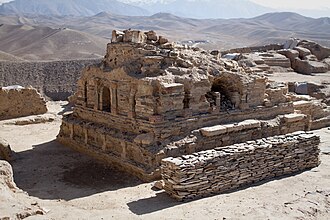
Early history[edit]
Excavations of prehistoric sites suggest that humans were living in what is now Afghanistan at least 50,000 years ago. Farming communities in the area were among the earliest in the world.[7] Northeast Afghanistan was an outpost of the Indus Valley Civilization, a mysterious culture that arose around the time of ancient Mesopotamia.[8]
Afghanistan's culture was gradually shaped by the various invasions it endured in its early history. Afghanistan's people were first conquered by Achaemenid Persia, which then fell to the armies of Alexander the Great.[9] The Persians labeled the native Afghan people as Paktyans, likely related to the modern name Pashtun.[10] After Alexander the Great rolled in, he did his typical routine of building a bunch of cities named after himself, including Alexandria-of-the-Arians (modern-day Herat); Alexandria-on-the-Tarnak (near Kandahar); Alexandria-ad-Caucasum (near Begram, at Bordj-i-Abdullah); and finally, Alexandria-Eschate (near Kojend), in the north.[9] Kandahar is also likely named after Alexander, as the most likely hypothesis of the name's origin has it evolving from Iskandar, Alexander's Persian name.[11]
Various Greek-led states controlled Afghanistan until one of them traded away half of Afghanistan in exchange for peace with the Mauryan Empire, a powerful civilization from India. Through Mauryan rule, Hinduism and Buddhism became entrenched in Afghanistan, and this cultural heritage remains to this day.[12] The Mauryans were skilled at communicating with the native Afghans and introducing their culture. One example of this is the Kandahar Bilingual Rock Inscription, an explanation of the concept of "Dharma", which Mauryan Emperor Ashoka had carved into an Afghan hillside in Greek and Aramaic.[13]
The traditions of Buddhism are stuck in Afghanistan, which is most visible in the construction of the Bamiyan Buddhas. These massive statues also displayed Greek influences in the design of their togas.[14] Tragically, these historically priceless monuments were demolished by the Taliban.
Afghanistan later bounced between various empires, mainly originating from Persia. The Afghan tribespeople was usually either autonomous or functionally independent.
Rise of Islam[edit]
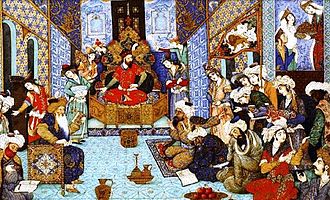
Arab Muslims brought Islam to Herat and Zaranj in 642 CE and began spreading eastward; some of the native inhabitants they encountered accepted it while others revolted. Before Islam was introduced, the people of the region were mostly Buddhists, Zoroastrians, and Hindus.[15] The first of the great Islamic Caliphates, the Rashiduns, largely failed to make significant inroads into Afghanistan due to ferocious resistance from the Pashtuns.[9] The struggle continued in Afghanistan under the following Caliphates until the Abbasid dynasty finally decided to call it quits in the 8th century.
As was the case in much of Africa and Southeast Asia, peace proved more effective than war in converting people to Islam. While conducting trade through the Silk Road, Muslim merchants gradually convinced the tribes of Afghanistan, a process largely completed by the end of the 9th century.[16] Meanwhile, Muslim Turkic speakers from elsewhere in Central Asia also aided the conversion by settling in Afghanistan while seeking better grazing land.[16] Despite converting to the Islamic religion, the Afghan tribespeople wasn't any more fond of imperial rule than before, and they remained functionally independent.
Eventually, Afghanistan became home to its empire, as the Ghaznavid dynasty became dominant in Central Asia. It was founded by Mahmud of Ghazni, who turned his hometown of Ghazni in Central Afghanistan into an imperial capital.[17] Drawing from Persian traditions and his zeal for Sunni Islam, Mahmud and his successor launched massive raids into India, bringing home loot and ensuring Islamic dominance in what is now Pakistan.[18]
Mongols and Mughals[edit]

“”If there is a paradise on earth, it is this, it is this, it is this.
|
| —Inscription at the grave of Babur in Kabul.[19] |
In 1220, Mongol warlord Genghis Khan rampaged with his hordes through Central Asia. Afghanistan also felt the brunt of the Mongol invasion, and many Afghan cities like Herat, Balkh, and Bamyan were destroyed and had their populations butchered.[20] This destruction had a lasting effect on Afghanistan's people; many of those displaced from the razed cities had no choice but to return to a rural agrarian lifestyle.[21] Even facing overwhelming strength, the Afghan people resisted the Mongol onslaught fiercely. During the 1221 siege of Bamyan, the Afghan garrison killed one of Genghis Khan's grandsons, a destabilizing loss that contributed to the later fragmenting of the Mongol Empire.[2]
Afghanistan later broke free of the Mongols and became an autonomous region of the Delhi Sultanate. This state of affairs persisted until 1370 when the infamous warlord Timur Lenk invaded Central Asia. Timur was a member of the Turkicized Barlas tribe. This Mongol subgroup had settled in Transoxania (now roughly corresponding to Uzbekistan) and converted to Islam after taking part in Genghis Khan’s son Chagatai's campaigns in that region.[22] Timur then became a powerful Mongol leader who declared himself the "defender of Islam" and launched genocides against Indian Hindus, Egyptian and Turkish "usurpers", and Middle Eastern Christians.[23][24] Timur founded his empire at Samarkand, but following his death in 1405, the capital moved southwest to Herat in Afghanistan. Under Timur’s son, Shah Rukh, Herat became one of the greatest medieval Islamic culture and learning centers.[25] Rukh prided himself as a patron of the arts, and he hired scholars, poets, and painters to beautify his court. His wife also commissioned grand projects from architects and had them build great monuments in Herat to display the glory of the Timurid Empire. The Timurid era in Herat is considered one of the greatest periods in Persian arts.[26]
Like so many others before it, the Timurid Empire collapsed due to a disputed succession and civil wars. Afghanistan's golden era wasn't done yet, though, as Timur's descendant Ẓahīr-ud-Dīn Muḥammad Babur rose out of Uzbekistan to establish a kingdom based out of Kabul.[27] He commissioned the Bagh-e Babur, or the "Gardens of Babur", a massive and splendid nature park in the middle of Kabul that is now a UNESCO World Heritage Site.[28] Babur's tomb is at the site, as he chose to be buried there.
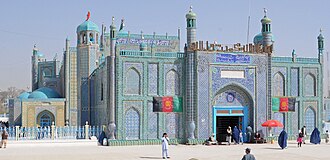
While in charge of Afghanistan, Babur launched several massive invasions into India. These conquests greatly expanded Babur's holdings to encompass much of northern India, and he declared himself the leader of a new realm: the Mughal Empire.[29]
The Mughal emperors understood very well that heavy-handed rule wouldn't work when dealing with the hardheaded tribes of Afghanistan. Mughal rule over Afghanistan was a combination of control over a few urban centers and benign neglect coupled with paying off tribes in the region, a formula later replicated by the British.[2] However, the Mughal rule was precarious, as various tribes were always rising against them. Another complication came from the Mughal Empire's rivalry with the Safavid Empire in Persia, and both states liked to fight each other over the Afghan region.[30] Various wars ensued, and Afghanistan changed hands multiple times. In 1748, the Mughals lost Afghanistan to the Safavids for the last time, and they basically gave up on the region due to other problems in the empire.[30] However, Afghanistan proved to be a bitter pill for the Persians to swallow. Early in the 18th century, one of the Pashtun tribes, the Hotaki, seized Kandahar from the Safavids, and a group of Ghilzai Pashtuns then raided the Safavid capital at Isfahan.[30] These revolts brought down the Safavid Empire, and Afghanistan was free again.[2]
The Great Game[edit]
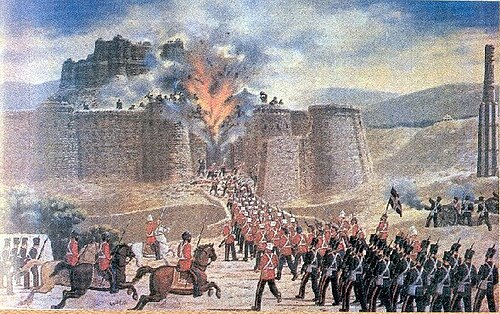
Afghanistan as we know it was founded in 1747 by Aḥmad Shah Durrānī, who united the Afghan tribes and founded an empire that encompassed much of Afghanistan and Pakistan.[31] He benefited in this quest from the weakening of the Mughal Empire, which was entering its death throes due to internal revolts. Unfortunately for them, Ahmad Shah's successors governed very ineptly, and they lost basically all of the conquered territories outside of Afghanistan's modern borders.[32] These humiliations led to civil wars in Afghanistan that greatly weakened it.
Unfortunately for them, this time of weakness came at a critical time. The British Empire and the Russian Empire expanded their holdings throughout the 18th and 19th centuries, and the two powers met in Afghanistan. The British were well aware that Afghanistan had served as an invasion route into India many times before. The power vacuum there left them fearful that the Russians would exploit that opportunity.[33] The Russians didn't like having the British nearby any better. Hence the two powers put an ungodly amount of effort into grappling over Afghanistan.
In 1837, the British demanded that Dost Mohammad, the new leader of Afghanistan, cease all diplomatic contact with Russia. When Mohammad told them to fuck off, the British decided that he had to go. In 1838, this began the First Anglo-Afghan War, as the British marched an army into Afghanistan to place the more pliable Shah Shuja onto the Afghan throne.[34] Called the "Disaster in Afghanistan", the war became a complete quagmire for the British. Although Dost Mohammad was easily deposed, the rebellious Afghan tribes turned to follow Mohammad Akbar and fought ferociously to resist the British.[35] The British lost, but they still inflicted great destruction and loss of life on Afghanistan. Dost Mohammad returned to the throne after the British withdrawal in 1842.

By 1854 the British wanted to resume relations with Dost Mohammad, whom they had essentially ignored for twelve years. The 1855 Treaty of Peshawar reopened diplomatic relations, proclaimed respect for each side's territorial integrity, and pledged mutual friendship.[36] After Dost Mohammad died, the new leader of Afghanistan, Sher Ali, realized that the British were using him as a meat shield against Russia, and relations between the UK and Afghanistan deteriorated again. When the Russians sent an envoy to Afghanistan in July 1878, the British were greatly alarmed and demanded that Ali receive British diplomats.[37] Ali didn't like being pushed around, and he refused. This refusal prompted yet another British invasion in 1878. This time, the invasion was costly but reasonably effective, and Afghanistan finally agreed in 1880 to exclusively maintain diplomatic relations with the British.[38]
As part of this war's aftermath, the British also decided to fully delineate the border between Afghanistan and the eastern frontier of the British Raj (now Pakistan).[39] In 1893, this resulted in the "Durand Line", which just so happened to split the Pashtun tribespeople.[40] This was done to serve colonial interests; the British wanted to keep Afghanistan as a buffer between itself and Russia, but it also didn't want Afghanistan to be large enough to pose a threat.[41] Hence the very literal divide and conquer.
For about 40 years afterwards, Afghanistan remained a loyal satellite of the British Empire. This relationship was also helped by the British strategy of bribing Afghanistan with a large subsidy.[42] However, things started to go sour again as the Afghan court became divided and the British Empire became preoccupied with World War I and its aftermath. To regain its independence, Afghanistan invaded the British Raj in 1919. Although suffering military defeat, the Afghans successfully won back their diplomatic independence from the British.[43] On a less happy note for Afghanistan, they still had to re-concede the Durand Line as their border, meaning that the Pashtuns would not be unified again.[44]
Independent kingdom[edit]

Amanullah Khan, the king of Afghanistan, began to implement a series of cultural reforms across his country during the 1920s. His reforms, had they been completed, would have been completely transformative. They included abolishing slavery and forced labor, introducing secular education for girls and boys, discouraging the veiling and seclusion of women, and establishing a national bank.[45] This opportunity was lost in 1928 when powerful religious figures unhappy about this wave of progressive policies rose up in open rebellion. The ensuing civil war resulted in the downfall of Amanullah Khan. In his place, Nadir Shah became king, and he abandoned most of the reform program to appease the anti-modernist forces in Afghanistan.[46] Despite this careful approach, Nadir Shah got himself assassinated in 1933 by a religious student.
Mohammed Zahir Shah succeeded to the throne and reigned from 1933 to 1973. His reign was a time of caution and tension. In terms of foreign policy, Afghanistan's primary concern was the Durand Line, as its Pashtun population wanted to be reunited with their relatives in Pakistan. In 1953, the king's prime minister and family relative Mohammed Daoud Khan started saber-rattling over the "Pashtunistan" issue, severely damaging relations between the two countries.[47] By 1963, the threat of war had become so severe that Zahir Shah had to step in to remove Daoud Khan from his post. After that, Afghanistan rewrote its constitution in 1964 to prevent any more blood relatives of the king from holding the post of prime minister, just to prevent Daoud Khan from ever getting his old job back.[48] Damn.
Zahir Shah slowly dragged his reluctant country into the modern age by taking a slower strategy focused on economics rather than culture. He attracted foreign investment aid to help build roads and infrastructure; much of the cash came from the Axis, especially Nazi Germany.[49] However, Afghanistan remained neutral and was neither a participant in World War II nor aligned with either power bloc in the Cold War. In fact, Afghanistan's government cleverly took advantage of the Cold War to woo investment money from both sides.
Communist rule[edit]

In 1973, Daoud Khan returned to enact his revenge against the monarchy for firing him. Khan assembled an alliance of young leftist military officers and forced the king to abdicate, declaring Afghanistan a republic with himself as the head of state.[50] That "republic" thing proved to be a lie when Khan rewrote the constitution to turn himself into a dictator.[51]
Even after coming to power, Daoud Khan did nothing to rectify the structural problems that had helped him to power. Afghanistan in the 1970s was a feudal country. Power lay not with urban businessmen but with great landowners who lived in countryside forts.[52] Most people were sharecroppers, who only kept about a third of what they produced. The local lords used hired thugs to terrorize people into compliance.[52] When Daoud Khan launched his coup, he met no opposition because no one was willing to die for the old order. Under Daoud Khan's rule, though, the old order remained firmly in place.
In April 1978, Daoud Khan ordered the assassination of a communist leader, Mir Akbar Khyber.[52] When Afghanistan's communists rallied at his funeral, Daoud Khan had them arrested. Realizing that time was short, the communists launched a short-order coup, and many of the same people who had brought Daoud Khan into power murdered him and his family in the presidential palace.[52][53] Along with them, the coup plotters killed about 100 other people while rolling tanks through the streets.[54]
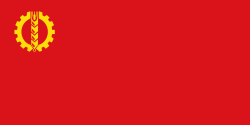
The communists declared that they had launched the "Great April Revolution". Reforms began immediately, with land being redistributed from landlord to peasant and abolishing the traditional "bride-price" for marriage.[52] The communists organized themselves into a new party, the People's Democratic Party of Afghanistan (PDPA), a Marxist-Leninist group aligned with the Soviet Union.[55]
Just as before, these reforms alienated the traditional populace of Afghanistan, and a popular revolt began against the new regime. Meanwhile, the PDPA crippled itself with infighting between hardliners and pragmatists, meaning that it could not effectively respond to the uprisings.[56] Many Afghans fled to Pakistan and Iran during this period to begin organizing a resistance movement to the "atheist" and "infidel" communist regime backed by the Soviets. Although the communists had popular support in the cities, this wasn't enough in an overwhelmingly rural country, and the PDPA became increasingly cruel in their attempts to suppress resistance. Between 1978 and 1992, the agents of the PDPA arbitrarily arrested thousands of civilians, including elders, religious leaders, intellectuals, women, farmers, civil servants, and shopkeepers. The PDPA subsequently tortured and killed a lot of these detainees.[57]
As happens in Afghanistan, the heavy-handed approach made things go straight to hell.
Soviet-Afghan War[edit]

Shit hit the fan in 1979 when the hardline Marxist-Leninists in the PDPA arrested most of the more pragmatic party members.[58] A few months later, the president of communist Afghanistan, Nur Mohammad Taraki, was assassinated by his even more hardline subordinate, Hafizullah Amin.[59] Amin's rule was even more unsteady, and he stupidly tried to prop up his power by killing many people. His misrule was so bad that the Soviet Union noticed, decided the situation on their southern border was unacceptable and sent in the Red Army to assassinate Amin and replace him with the moderate Babrak Karmal.[59]

Afghanistan had been a concern for the Soviet Union for a long time. They feared that the United States could take advantage of the country's fragile political situation to gain a political foothold right below the Soviet Union's soft underbelly. During a series of meetings in December 1979, Soviet leader Leonid Brezhnev decided that the Soviet Union needed to replace Afghanistan's political leadership and send armed forces to restore order to the country as a whole.

The Soviet deployment began on Christmas Eve; warplanes started landing in Kabul, and armored vehicles rolled across the land border.[60] The Soviet invasion created an immediate global uproar. Over five dozen countries—including the United States, Canada, China, Japan, and West Germany—boycotted the 1980 Summer Olympics held in Moscow.[61]

Back in Afghanistan, hot diarrhea hit the fan. The Islamic insurgents of Afghanistan called the mujahideen, or "those who fight", declared a jihad against the Soviet invaders. Although the Soviets had superior resources and weaponry, the Afghans were fighting on their rugged home turf and were willing to basically fight forever in the name of God.[62] The initial Soviet invasion was successful, and they took control of most of Afghanistan's major cities by early 1980.[62] However, units in the Afghan army repeatedly defected to the mujahideen, and the insurgency consistently controlled around 80% of Afghanistan.[62] With the Afghans completely unwilling to die in the name of Marxism-Leninism, the Soviets had to do it themselves. That got even worse when the Soviets figured out that conscripted Central Asians also weren't willing to follow orders from Russian commanders who told them to kill their fellow Central Asian Muslims.[62] Russian soldiers realized they were in a hopeless situation; they made the best of things by making their own alcohol and buying opium from the locals, and boozing the days away.[63]
While Afghanistan spat in the face of the world's second superpower, it also received aid from the world's first superpower. In response to the Soviet invasion, the United States conducted one of its most successful covert action programs during the Cold War. US aid started slowly under Jimmy Carter and rapidly increased as the Afghan insurgents became more and more successful. The CIA provided about $60 million per year to the Afghan mujahideen between 1981 and 1983, matched by assistance from Saudi Arabia.[60] Beginning in 1985, the United States increased its support to the Afghans to $250 million per year.[60] Meanwhile, angry and bitter youths were encouraged to travel to Pakistan to attend Saudi-run religious schools, explicitly instilling a sense of fanatical religious hatred.[64] Ronald Reagan escalated things again by authorizing the transfer of weapons, technical advice on weapons and explosives, intelligence, and technology like wireless interception equipment to Afghanistan.[60]
After a while, the Soviets could no longer hide that things were going south. Despite official press censorship, people in the Soviet Union began to hear that the war was not going well from their conscripted family members. They also noticed that many of those conscripted family members came home in boxes.[62] Soviet leader Mikhail Gorbachev started receiving angry letters from Soviet citizens, especially mothers angry at burying their children.[60] Amid these domestic political concerns, the Soviets finally decided to withdraw in 1989. About 1.5 million Afghans had died.[64]
Civil war[edit]

So, let's flashback to 1989. Afghanistan is in ruins. The central government is barely a figurehead. Many pissed-off radicalized youths are sitting around with nothing else to do. What a great time to have a civil war!
Even after the Soviet defeat, the old communist regime in Afghanistan survived, now under the leadership of President Najibullah. To survive, the government ditched any claim of socialism in favor of focusing on nationalism and Islamism.[65] It wasn't enough. The insurgents, fresh from fighting the Soviets, almost immediately turned to attack the government in Kabul as well. Although the government won the first engagements, the insurgents received significant aid from Pakistan's intelligence services.[66] Absent Russian help, Najibullah's defeat was only a matter of time. The first phase of the war ended with a coalition agreement between the various rebel factions. Peace was short-lived.
The shit started again when instability in Kabul made it clear that the government was going up for grabs. At that point, about five or six different former mujahideen armies attacked each other and started throwing rockets all around Kabul.[67] That, of course, wasn't great for the civilians living there.
A similar process was happening across Afghanistan's major cities. In Kandahar, militia members went around gang-raping women during the chaos.[67] This outrage came to the attention of former mujahideen commander Mullah Omar. He was so furious that he organized a band of his followers to capture and hang many of those criminals. He then declared another jihad, focused on reuniting Afghanistan and punishing the criminal warlords. Through the smart policy of just being less shitty than the other warlord groups, Mullah Omar's followers gained significant popular support and received covert aid from the US and Pakistan.[68] They called themselves the Taliban, which is Pashto for "students".[69] By 1996, they had consolidated control over most of Afghanistan.
Taliban rule[edit]

Once in power, the Taliban proved to be a whole different kind of shitty. They weren't rapacious like the warlords, but they were Islamist fanatics. Governing as the "Islamic Emirate of Afghanistan",[70] the Taliban's rule was relentlessly totalitarian. Their assumption of power was quickly followed by a slew of morality regulations in line with the strictest interpretations of Islamic law. These regulations range from the terrifying to the ridiculous.
Women suffered the most under the Taliban. They were not allowed to leave the house unless covered from head to toe, a policy enforced by the threat of physical punishment by the Taliban's religious police.[71] Female patients were only allowed to see a male physician if accompanied by a close male relative.[71] These restrictions even extended to foreigners. The Taliban demanded that female humanitarian aid workers not be permitted to drive, as such a thing was "against Afghan tradition and has a negative impact on the society."[72]
This was in contrast to the communist regime that came before and even the kingdom before that. Women received the right to vote in the 1920s, and as early as the 1960s, the Afghan constitution provided equality for women.[73] For all its failings, the PDPA continued that trend to the point that by 1977, women were 15% of Afghanistan's highest legislative body. By the early 1990s, 70% of schoolteachers, 50% of government workers and university students, and 40% of doctors in Kabul were women.[73]
Of course, it's not like the Taliban were much more lenient on men. Men could be jailed for up to ten days by the religious police for trimming or cutting their beards, a "crime" that was easily detected because the Taliban regularly had its fighters patrol Afghanistan's cities and countryside.[74] The Taliban also banned music, kite-flying, photographs, television, feeding pigeons, dancing, and "sorcery."[71] It's the kind of thing that would almost be funny if it didn't happen in real life. The Taliban also required non-Muslims to wear yellow badges identifying them as such because it's not like that would raise any red flags.[75]
One of the more infamous incidents under Taliban rule concerned the Bamyan Buddhas, the massive monuments left over from Afghanistan's Buddhist days. For whatever reason, the Taliban randomly decided in 2001 to blow them up for being icons.[76] These priceless cultural artifacts are now gone forever.
Afghanistan War (2001–2021)[edit]
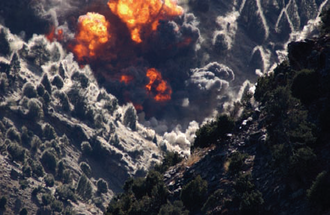
“” How could the world’s sole superpower have battled continuously for more than 16 years – deploying more than 100,000 troops at the conflict’s peak, sacrificing the lives of nearly 2,300 soldiers, spending more than $1tn (£740bn) on its military operations, lavishing a record $100bn more on “nation-building”, helping fund and train an army of 350,000 Afghan allies – and still not be able to pacify one of the world’s most impoverished nations?
|
| —Alfred W McCoy, writing for The Guardian in 2018.[77] |
While all of that Taliban shit was going down, the rest of Afghanistan was hardly in a state of peace. Since the Taliban took over in 1996, they have struggled against various enemies. This was because the Taliban was a Pashtun nationalist group, and they made enemies out of Afghanistan's ethnic minorities, especially the Tajiks.[78] Those ethnic minorities rallied behind many opposition groups, most significantly the Northern Alliance.[79]
As just about everybody knows, everything changed in 2001 due to the 9/11 attacks. The Taliban were Pashtun tribesmen and thus lived their lives according to the ancient Pashtunwali code. Part of Pashtunwali is the concept of "Nanawatai", which obligates Pashtuns to accept and protect all those who seek their refuge and hospitality no matter what the cost.[80] When Osama bin Laden abruptly became the world's most wanted criminal, he invoked Nanawatai by asking that the Taliban not hand him over to the US The Taliban agreed, which seriously pissed off the United States.
Bin Laden had, for some time, been operating out of Afghanistan, having burned all of his other bridges.[81] While the Taliban condemned the terrorist attacks, they refused to hand Bin Laden over to the US, claiming they wanted the United Nations to investigate and tell them what to do.[82] The US retaliated by launching airstrikes, which terrified the Taliban into offering to hand Bin Laden off to a third party.[83] That wasn't good enough for the US, and the Americans went off to war. The resulting conflict clearly demonstrated that the US had learned no lessons from Afghanistan's history.
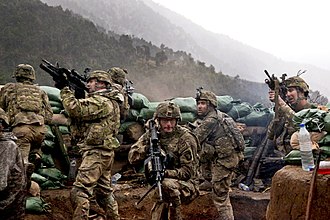
The war seemed to go well at first despite a severe lack of competent planning. US Secretary of Defense Donald Rumsfeld rejected most war planning in favor of jumping in feet first and eyes closed.[84] The US also relied heavily on airpower, which was stupid since Afghanistan had gone through decades of insurgency war and thus had no good static military targets to bomb.[85] Instead of sending in large numbers of US troops, the Americans relied heavily on local allies like the Northern Alliance, who proved unreliable.[86]
Unfortunately, the Bush administration didn't have a military plan for apprehending Bin Laden; the rejection of the Taliban's offer effectively gave the terrorist a get-out-of-jail-free card.[87] The US actually had a good chance at getting Bin Laden in 2002 during the Battle of Tora Bora; due to incompetence, this opportunity was squandered.[88][89]
However, the initial ground offensive was a success, and the Taliban's leader Mohammad Omar surrendered the Taliban's primary city of Kandahar in November 2001, formally ending the Taliban's formal rule over Afghanistan.[90] Around the same time, the U.S.-aligned Northern Alliance captured Afghanistan's capital city of Kabul.[91] This wasn't the end of things, as Al-Qaeda, Taliban loyalists, and other Afghans and foreigners rallied to continue the fight as an insurgency that continues to this day.
In 2004, Hamid Karzai became Afghanistan's first-ever elected leader.[92] Afghanistan was theoretically a republic, albeit a dysfunctional and corrupt Islamist one. The Taliban, meanwhile, regrouped with their Pashtun brothers across the Durand Line in Pakistan[93] and formed a government-in-exile that was brutal and murderous but often seemed more effective than the internationally-recognized one.[94]
Over 241,000 people have died due to the American-led war in Afghanistan, including over 71,000 civilians.[95] So it goes.
In 2010 Afghanistan was discovered to hold vast stores of mineral wealth, as the New York Times reported. The Pentagon even assessed that this could turn Afghanistan into a global "mining center."[96] Perhaps not coincidentally, this article was released around the time that the war started going bad for the US, leading to criticism that this discovery of mineral wealth would be used as a justification to further American imperialism in the region indefinitely.[97] Of course, America didn't stay indefinitely, but it did stay for 11 more years after the article was published. Perhaps unsurprisingly, after American withdrawal a flurry of articles were released crying out that the Taliban now controlled Afghanistan's vast mineral wealth, with the subtext being that America didn't.[98][99] Make of that what you will.
Taliban takeover and Islamic Emirate[edit]
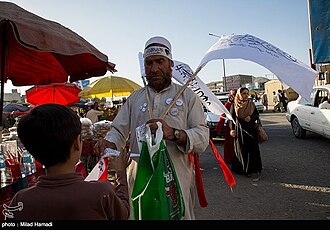
In February 2020, President Donald Trump signed a conditional peace agreement with the Taliban and began withdrawing U.S. troops. In April 2021, President Joe Biden announced that all remaining troops would be withdrawn by September. During August, the Taliban quickly began seizing parts of the country, culminating in the Taliban's capture of the capital city of Kabul on 15 August. While resistance continues, one of the last resistance strongholds (Panjshir Valley) fell to the Taliban at the start of September.[100]
In the course of withdrawing a US military presence, a coalition of the US, UK, and others quickly moved to evacuate their own citizens and Afghans who may have assisted the coalition during the conflict, with total evacuees numbering at least 123,000.[101] During this mass evacuation, a member of ISIS-K murdered at least 95 people and injured many more at the Kabul airport, where the evacuation was taking place.[102] In a show of violence begetting violence, the US launched two retaliatory drone strikes against ISIS members that resulted in some dead ISIS agents in exchange for 10 innocent civilians.[103] What a great way to cap a 20-year occupation.
Despite various promises to promote equality and provide amnesty to Afghan loyalists- even explicitly saying that Taliban enforcers will not go door to door seeking retribution[104] - the Taliban quickly began showing their true colors. It was reported that the Taliban started hunting down and executing former members of the Afghan military[105][106] and hunting down others who had collaborated with the US or had worked for the Afghan government.[107]
On 7 September, the Taliban announced the new government of the Islamic Emirate of Afghanistan. This included Mullah Mohammad Hassan Akhund, a senior member of the last Taliban government, as Interim Prime Minister. Sirajuddin Haqqani, who is wanted by the FBI, got the position of Interior Minister.[108]
Almost immediately after the Taliban took over, the Afghanistani economy and bank system collapsed, which has led the country to face famine.[109][110] It has now reversed back to the extreme Islamic laws and has become embroiled in an ongoing conflict against the local ISIS branch.
Isolation and the opium trade[edit]
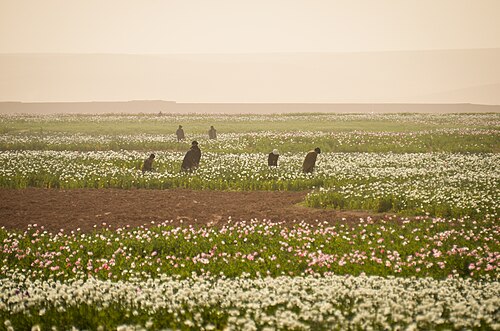
As a result of international shunning of the Taliban regime, many people in Afghanistan have found no recourse but to grow and sell poppy, primarily for international export.[111] Farmers, soldiers, and local leaders have been told that prosecuting the drug economy is "vital" to securing much needed humanitarian aid, but dealers and users in Kabul, where particularly harsh crackdowns have occurred, have said that supply is "undiminished," and have even alleged that Taliban soldiers themselves are dealing drugs on the side.[111] The Taliban's own "war on drugs" also runs the risk of alienating the Taliban's traditional base of support, whose income derives in large part from the opioid industry.[111]
As Foreign Policy Magazine explains:[111]
“”With international aid and trade largely suspended, opium and meth became the last economic lifeline for many in provinces such as Kandahar and Helmand. In a country where the public sector minimum wage is under $60 per month, foraging for ephedra can bring in $30 per day, which, although laborious, takes no special skills or investment—traders even travel to pick up the product. In the traditional Taliban stronghold of Kandahar, poppy cultivation raises around $400 million a year for farming families.
|
One Talib soldier in particular has explained that in the 15 years he has worked for the Taliban, he has never received a salary:[111]
“”...including the 30-year-old Talib resting his Kalashnikov rifle on his knees in the front seat of our car. The soldier said he has received no salary for the 15 years that he has served in the Taliban forces and doesn’t know how he’ll support his family without growing opium.
|
While an uninterrupted supply does not itself prove that cultivation of opium has continued under Taliban rule, it does contradict official Taliban claims that heroin and opium has been eradicated from Afghanistan.[111] In fact there is evidence that the Taliban has consented to continued opium production. Some farmers have openly told journalists that they were "allowed" to go ahead with the harvest of their yields, and India has busted a heroin production operation ran by Afghan nationals.[111]
Government of the fallen republic[edit]
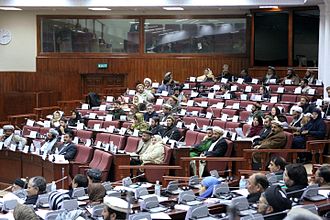
Elections and incompetence[edit]
After the US rolled in and threw the Taliban out of Kabul, Afghanistan was theoretically a democratic republic. Theoretically. On paper, Afghanistan's new government has all of the limbs and extremities it should have, like a legislature and an independent judiciary. In reality, structural deficiencies have persisted from the very beginning. In the first round of elections in 2005, Hamid Karzai, Afghanistan's first president, immediately set about preventing the formation of powerful political parties and instead favoring an ethnic-loyalty-based approach.[112] His strategy for maintaining power was getting the majority Pashtun ethnic group, of which he is a member, to support him just because he is a fellow Pashtun. As other historical examples have shown, organizing politics around ethnicity never ends well.
From that stellar beginning, the Afghan government has transformed into a useless and untrustworthy institution. The government did nothing to bolster its legitimacy against the Taliban and took no action against corruption or poverty. Things then really went south in the 2014 elections, where the government disqualified 16 candidates, and everybody left accused everybody else of committing election fraud.[113] The two lead candidates agreed to form a "unity government", which has proven even more ineffective than what came before. Corruption got worse, elections were repeatedly postponed, opposition groups faced official hostility, and insurgent groups attacked civilians with impunity.[114]
And it's not like the people don't want democracy to work. In February 2020, the Afghan Institute for Strategic Studies conducted a general survey across Afghanistan's 34 provinces which found that over 68 percent of respondents preferred the post-2001 political system compared to the Taliban's theocracy; over 80 percent of respondents believed that popular elections made the government legitimate. About 80 percent also supported most elements of a democratic regime, such as women’s rights and liberties, social equality, and freedom of expression.[115] These results show that Afghanistan's democracy problems come from the top, not the bottom.
Corruption[edit]

“”Our government is weak and ineffective in comparison to other governments. But the big corruption, the hundreds of millions of dollars of corruption, it was not Afghan. The contracts, the subcontracts, the blind contracts given to people, money thrown around [by the US] to buy loyalties, money thrown around to buy submissiveness of Afghan government officials, to policies and designs that the Afghans would not agree to. That was the major part of corruption.
|
| —Hamid Karzai responds to corruption allegations against his government in 2013.[116] |
Apart from terrorism, Afghanistan's biggest problem seems to be corruption. Various corruption watchdog reports regularly indicate corruption is endemic throughout Afghan society; officials collect bribes, police participate in crimes, people are jailed arbitrarily to coerce payment from family members, taxes are just entirely fucked, and the black market is omnipresent.[117] In US dollars, Afghans paid an estimated $3 billion in bribes.[117] Part of that is just cultural, as Afghans have always done business based on personal, familial, ethnic, and historical relationships rather than laws.
However, a lot of that corruption can be traced back to the fact that the US has irresponsibly dumped billions of dollars into the region without really giving a shit where that money went. This came to light when Hamid Karzai complained about the media's portrayal of his government as a kleptocracy by acknowledging the fact and then pointing out that much of the responsibility for that fact lay at Americans' feet. Michael Kugelman, deputy director of the Asia Program at the U.S.-based Wilson Center, assessed Karzai's comments by saying: "I'm not sure I'd go so far as to say that the US used corruption as a tool, but... US officials have thrown huge amounts of money at Afghanistan knowing full well that this would lead to more corruption than development or peace."[118] Indeed, the Office of the Special Inspector General for Afghanistan Reconstruction, or SIGAR, estimated that 40% of US aid to Afghanistan since 2001 has been pocketed by officials, gangsters, warlords, drug lords, and insurgents.[119]
Gallery[edit]
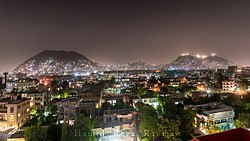
Kabul by night.
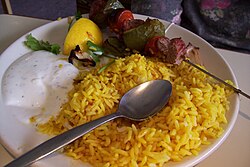
Afghan lamb kebab with yellow saffron rice.

Band-e Amir National Park in Bamyan Province.
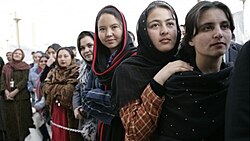
Afghan women.
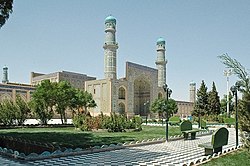
The Great Mosque of Herat.
See also[edit]
- George W. Bush
- War on Terror
- Iraq War
- Iran
- Pakistan
References[edit]
- ↑ The Young British Soldier. Poetry Lovers' Page.
- ↑ 2.0 2.1 2.2 2.3 2.4 Why Is Afghanistan the ‘Graveyard of Empires’? The Diplomat.
- ↑ Experts Mull US Legacy After 20 Years in Afghanistan VOA News.
- ↑ Pashtunwali Afghanistan Language and Culture Program.
- ↑ Rashid, Ahmed (2000), Taliban, p. 187, ISBN 1 86064 417 1
- ↑ Afghanistan. US State Department.
- ↑ Langer, William L., ed. (1972). An Encyclopedia of World History (5th ed.). Boston, MA: Houghton Mifflin Company. pp. 9. ISBN 0-395-13592-3.
- ↑ Indus Valley Civilization. Ancient History Encyclopedia.
- ↑ 9.0 9.1 9.2 See the Wikipedia article on History of Afghanistan.
- ↑ Houtsma, Martijn Theodoor (1987). E.J. Brill's first encyclopaedia of Islam, 1913-1936. 2. BRILL. p. 150. ISBN 90-04-08265-4. Retrieved 2010-09-24.
- ↑ See the Wikipedia article on Kandahar.
- ↑ Puri, Baij Nath (1987). Buddhism in central Asia. Motilal Banarsidass. p. 352. ISBN 81-208-0372-8.
- ↑ See the Wikipedia article on Kandahar Bilingual Rock Inscription.
- ↑ The History of Afghanistan's Bamiyan Buddhas. ThoughtCo.
- ↑ Ende, Werner; Steinbach, Udo (15 April 2010). Islam in the World Today: A Handbook of Politics, Religion, Culture, and Society. Cornell University Press. p. 257. ISBN 9780801464898.
At the time of the first Muslim advances, numerous local natural religions were competing with Buddhism, Zoroastrianism, and Hinduism in the territory of modern Afghanistan.
- ↑ 16.0 16.1 Afghanistan: Islamic Conquest. Country Studies.
- ↑ See the Wikipedia article on Mahmud of Ghazni.
- ↑ Ghaznavid and Ghorid Rule. Country Studies.
- ↑ Bagh-e Babur Garden, Kabul, Afghanistan. Oriental Architecture.
- ↑ Central Asian world cities? University of Washington.
- ↑ Obama's war: Deploying 17,000 raises stakes in Afghanistan. USA Today.
- ↑ Timur. Britannica.
- ↑ Tamerlane’s Reign of Terror History Answers UK
- ↑ 10 Terrors Of The Tyrant Tamerlane Listverse
- ↑ Herat: History. Lonely Planet.
- ↑ The Art of the Timurid Period (ca. 1370–1507). Metropolitan Museum of Art.
- ↑ See the Wikipedia article on Babur.
- ↑ See the Wikipedia article on Gardens of Babur.
- ↑ The Mughal Empire in India. ThoughtCo.
- ↑ 30.0 30.1 30.2 Mughal-Safavid Rivalry, ca. 1500-1747. Country Studies.
- ↑ Aḥmad Shah Durrānī. Britannica.
- ↑ Ahmad Shah. Country Studies.
- ↑ The Great Game. Country Studies.
- ↑ See the Wikipedia article on First Anglo-Afghan War.
- ↑ The First Anglo-Afghan War. Country Studies.
- ↑ The Second Anglo-Afghan War. Country Studies.
- ↑ The Second Anglo-Afghan War (1878-1880). ThoughtCo.
- ↑ The Second Anglo-Afghan War (1878-1880). ThoughtCo.
- ↑ See the Wikipedia article on Second Anglo-Afghan War.
- ↑ The Durand Line National Geographic.
- ↑ See the Wikipedia article on The Great Game.
- ↑ See the Wikipedia article on Third Anglo-Afghan War.
- ↑ Barthorp, Michael (2002) [1982]. Afghan Wars and the North-West Frontier 1839–1947. London: Cassell. ISBN 0-304-36294-8., p. 157
- ↑ Tom Lansford (16 February 2017). Afghanistan at War: From the 18th-Century Durrani Dynasty to the 21st Century. ABC CLIO. p. 146.
- ↑ See the Wikipedia article on Afghan Civil War (1928–1929).
- ↑ Hafizullah, Emadi (2005). Culture and customs of Afghanistan. Greenwood Publishing Group. p. 35. ISBN 0-313-33089-1.
- ↑ Afghanistan: History Of 1973 Coup Sheds Light On Relations With Pakistan. Radio Free Europe.
- ↑ Eur (2002). The Far East and Australasia. 2003. Psychology Press. p. 62. ISBN 978-1-85743-133-9.
- ↑ Anthony Hyman (27 July 2016). Afghanistan under Soviet Domination, 1964–91. Springer. p. 46. ISBN 978-1-349-21948-3.
- ↑ See the Wikipedia article on 1973 Afghan coup d'état.
- ↑ Kamali, Mohammad Hashim (January 1985). Law in Afghanistan: A Study of the Constitutions, Matrimonial Law and the Judiciary. ISBN 9004071288.
- ↑ 52.0 52.1 52.2 52.3 52.4 Remembering the Saur Revolution. Jacobin.
- ↑ See the Wikipedia article on Saur Revolution.
- ↑ An April Day That Changed Afghanistan 1: Four decades after the leftist takeover. Afghanistan Analysts Network.
- ↑ See the Wikipedia article on People's Democratic Party of Afghanistan.
- ↑ Communism and Rebellion. Country Studies.
- ↑ Shadow Report on the Realization and Implementation of the UN Convention against Torture and Other Cruel, Inhuman or Degrading Treatment or Punishmeut in Afghanistan. Afghanistan Independent Hnman Rights Commission (AIHRC).
- ↑ Rasanayagam, Angelo (2005). Afghanistan: A Modern History. I.B.Tauris. p. 73. ISBN 978-1850438571.
- ↑ 59.0 59.1 Afghanistan: 20 years of bloodshed. BBC News.
- ↑ 60.0 60.1 60.2 60.3 60.4 The Soviet Experience in Afghanistan: Getting History Right. Lawfare.
- ↑ See the Wikipedia article on 1980 Summer Olympics boycott.
- ↑ 62.0 62.1 62.2 62.3 62.4 The Soviet Invasion of Afghanistan, 1979 - 1989. ThoughtCo.
- ↑ BOOZING THROUGH THE SOVIET–AFGHAN WAR WAS MORE HORRIFYING THAN YOU CAN IMAGINE. War on the Rocks.
- ↑ 64.0 64.1 History of the Taliban. ThoughtCo.
- ↑ Barfield, Thomas (2012). Afghanistan: A Cultural and Political History. Princeton University Press. ISBN 978-0-691-15441-1. p. 239, 244
- ↑ See the Wikipedia article on Afghan Civil War (1989–1992).
- ↑ 67.0 67.1 Chaos After Soviet Withdrawal Gave Rise To Taliban. NPR.
- ↑ The Taliban in Afghanistan. by Zachary Laub. Council on Foreign Relations.
- ↑ Taliban. Britannica.
- ↑ See the Wikipedia article on Islamic Emirate of Afghanistan.
- ↑ 71.0 71.1 71.2 Taliban Rules, Decrees, Laws and Prohibitions. ThoughtCo.
- ↑ Taliban bars women aid drivers. CNN.
- ↑ 73.0 73.1 Report on the Taliban's War Against Women. US State Department Archives.
- ↑ Taliban religious police jail beard-trimmers for 10 days. Rawa News.
- ↑ Taliban Defends Plan for Labeling Non-Muslims. PBS.
- ↑ See the Wikipedia article on Buddhas of Bamyan.
- ↑ How the heroin trade explains the US-UK failure in Afghanistan. The Guardian.
- ↑ The Taliban and the Changing Nature of Pashtun Nationalism. National Interest.
- ↑ See the Wikipedia article on Northern Alliance.
- ↑ See the Wikipedia article on Nanawatai.
- ↑ 911 Commission 2004, p. 66.
- ↑ Taliban defy Bush ultimatum The Guardian. September 21, 2001
- ↑ Bush rejects Taliban offer to surrender bin Laden The Independent. 15 October 2001
- ↑ 21st Century Horse Soldiers – Special Operations Forces and Operation Enduring Freedom Defense Media Network
- ↑ Special forces and horses Armed Forces Journal
- ↑ First In: An Insider’s Account of How the CIA Spearheaded the War on Terror in Afghanistan CIA. Review. J. Daniel Moore
- ↑ US Refusal of 2001 Taliban Offer Gave bin Laden a Free Pass
- ↑ We Really Did Have a Chance at Bin Laden Brookings Institute
- ↑ How Osama bin Laden Escaped Foreign Policy
- ↑ [Collapse of the Taliban] The Guardian.
- ↑ The Rise and Fall of the Taliban
- ↑ See the Wikipedia article on Politics of Afghanistan.
- ↑ Al Qaeda Finds Its Center of Gravity The New York Times. Sep 10, 2006
- ↑ Taliban shadow officials offer concrete alternative. Washington Post.
- ↑ AFGHAN CIVILIANSCosts of War
- ↑ U.S. Identifies Vast Mineral Riches in Afghanistan[a w], New York Times
- ↑ Afghanistan Strikes It Rich[a w], Mother Jones
- ↑ The Taliban are sitting on $1 trillion worth of minerals the world desperately needs[a w], CNN
- ↑ China Eyes Afghanistan’s $1 Trillion of Minerals With Risky Bet on Taliban[a w], Bloomberg
- ↑ https://www.bbc.co.uk/news/world-asia-58484155
- ↑ https://www.bbc.com/news/world-asia-58283177
- ↑ https://www.bbc.com/news/world-asia-58349010
- ↑ https://www.npr.org/2021/08/30/1032367184/rockets-kabul-airport-deadline-us-troops-bomb
- ↑ https://www.npr.org/2021/08/17/1028376093/taliban-announces-amnesty-urges-women-to-join-government
- ↑ https://www.telegraph.co.uk/world-news/2021/08/31/taliban-hunting-killing-former-members-afghan-army/
- ↑ https://news.yahoo.com/taliban-hunting-executing-u-allied-145335282.html
- ↑ https://www.bbc.co.uk/news/world-asia-58271797
- ↑ https://www.bbc.co.uk/news/world-asia-58235639
- ↑ https://www.hrw.org/news/2021/11/11/afghanistan-facing-famine#
- ↑ https://www.statista.com/chart/amp/26339/afghanistan-acute-food-insecurity-snapshot-figures/
- ↑ 111.0 111.1 111.2 111.3 111.4 111.5 111.6 Afghanistan: The Taliban's "War on Drugs" Could Backfire[a w], Foreign Policy Magazine
- ↑ Afghanistan’s New Legislature: Making Democracy Work. International Crisis Group.
- ↑ See the Wikipedia article on 2014 Afghan presidential election.
- ↑ Is Democracy Dying in Afghanistan? The Diplomat.
- ↑ What Kind of Government Do Afghans Want? The Diplomat.
- ↑ Afghanistan's Hamid Karzai says Nato caused 'great suffering'. BBC News.
- ↑ 117.0 117.1 Corruption. Global Security.
- ↑ Afghanistan’s Karzai says American cash fed corruption. Military Times.
- ↑ US spending in Afghanistan fueled rampant corruption, reports say. Public Radio International.
Categories: [Authoritarian regimes] [Government incompetence] [Islamic extremism] [Islamism] [Ongoing armed conflicts] [South Asian countries] [Terrorism] [Theocracy] [Totalitarianism] [Purity culture] [Racism] [Homophobia] [Transphobia]
↧ Download as ZWI file | Last modified: 11/07/2025 11:10:29 | 117 views
☰ Source: https://rationalwiki.org/wiki/Afghanistan | License: CC BY-SA 3.0

 KSF
KSF